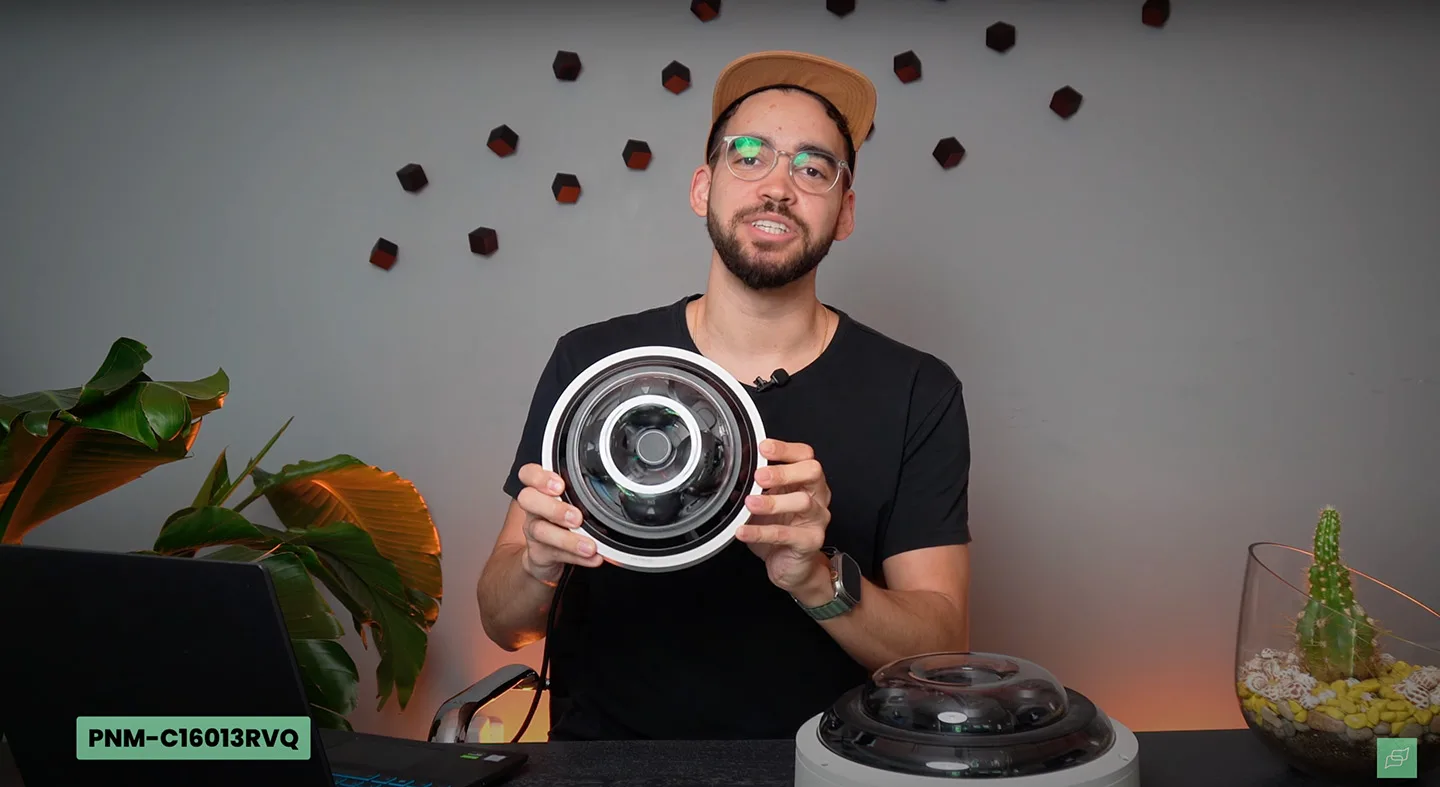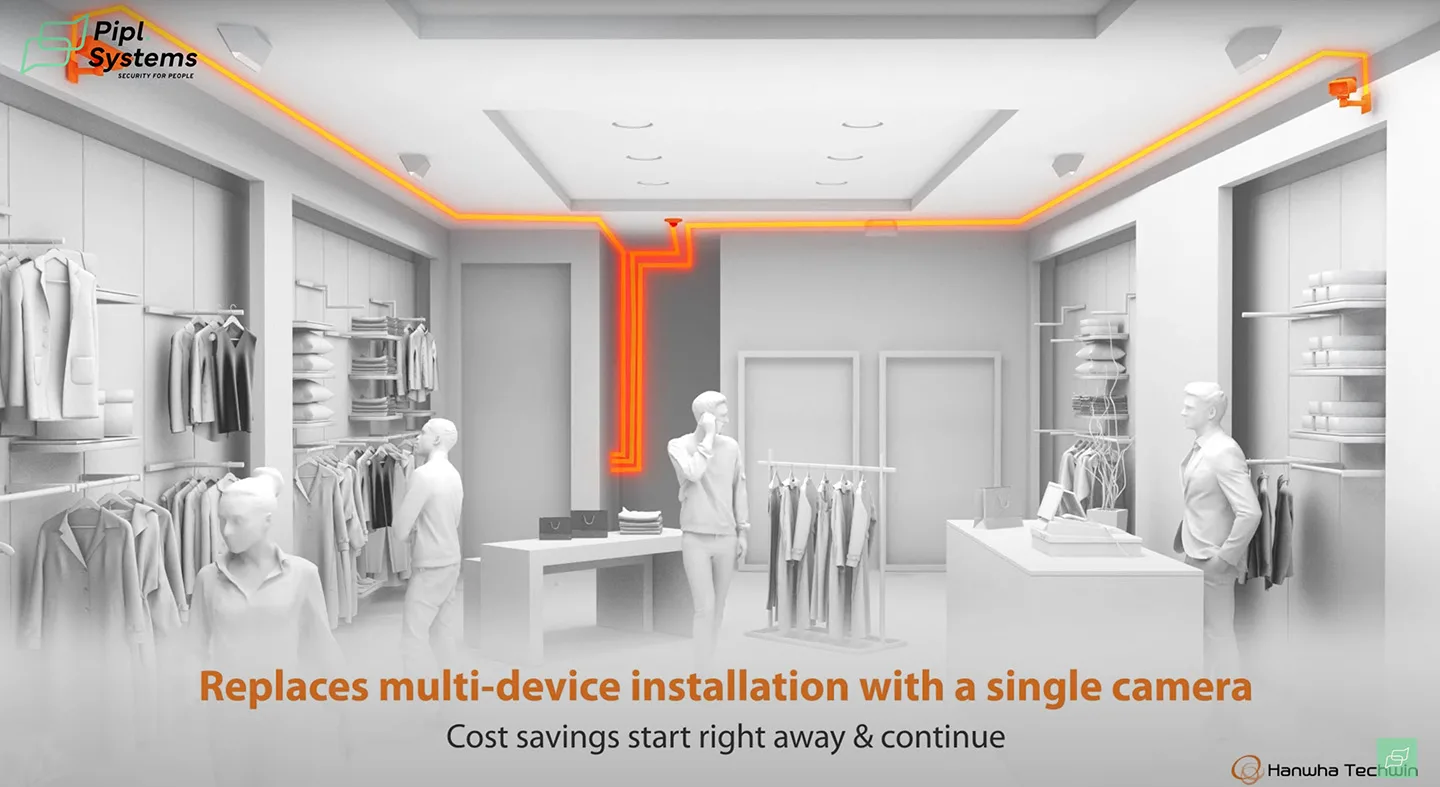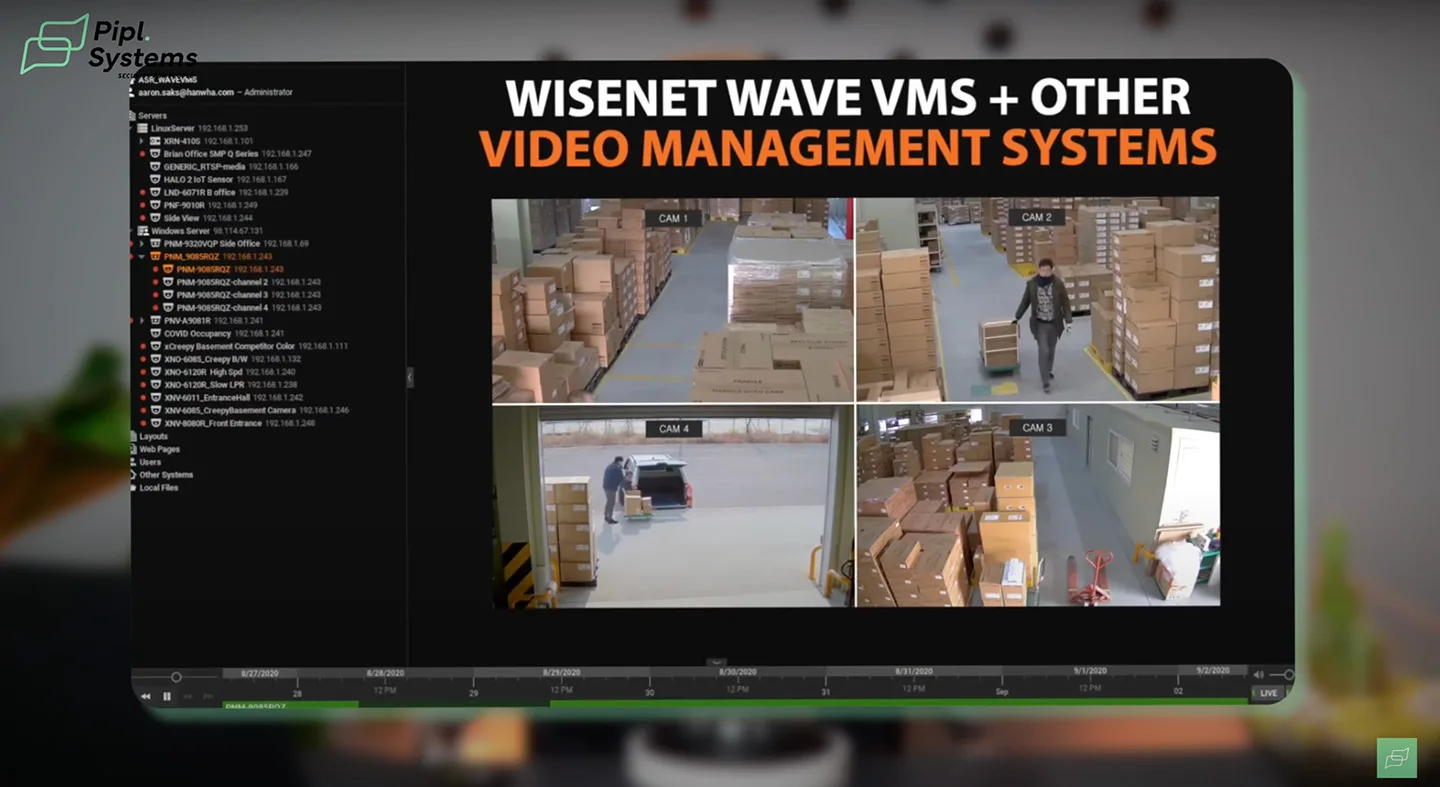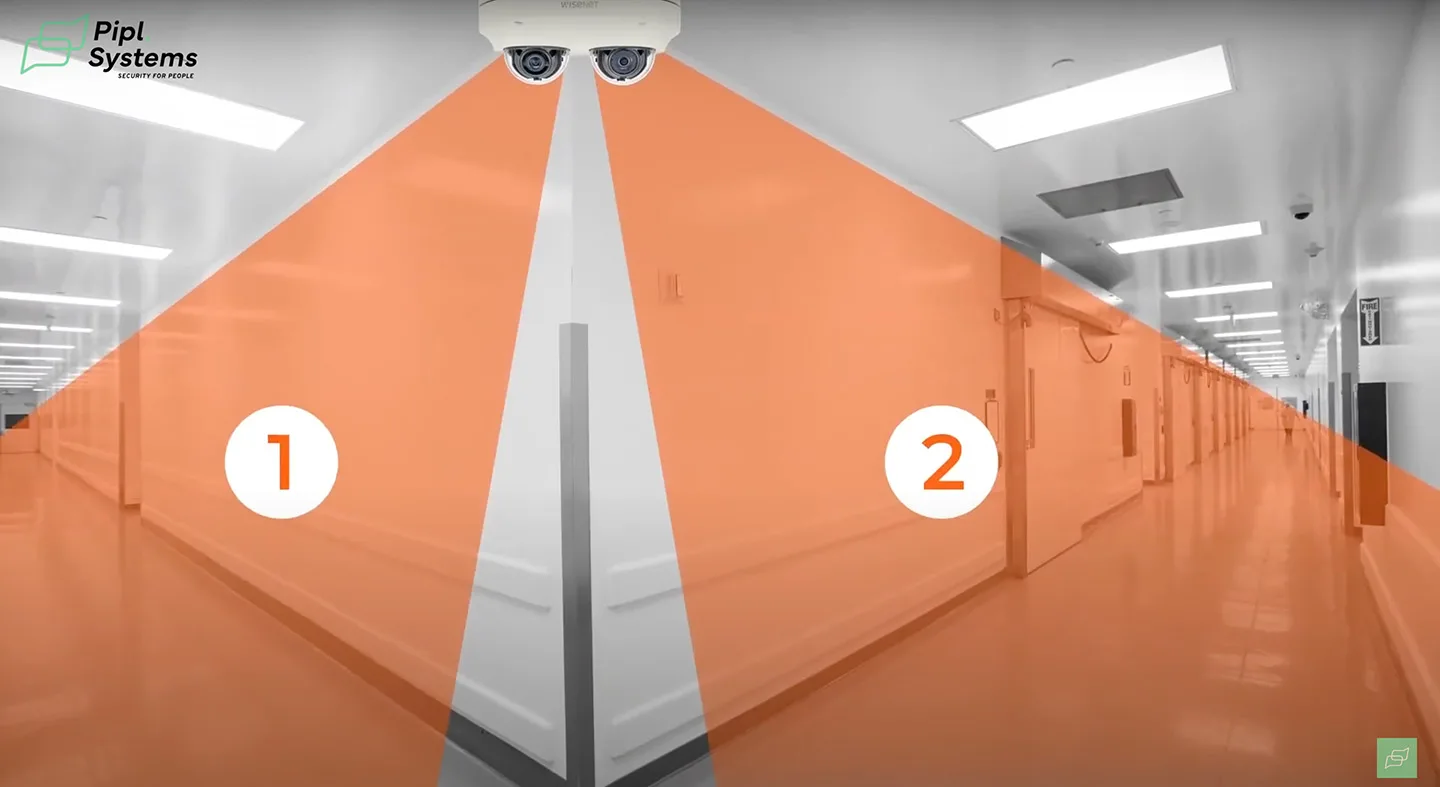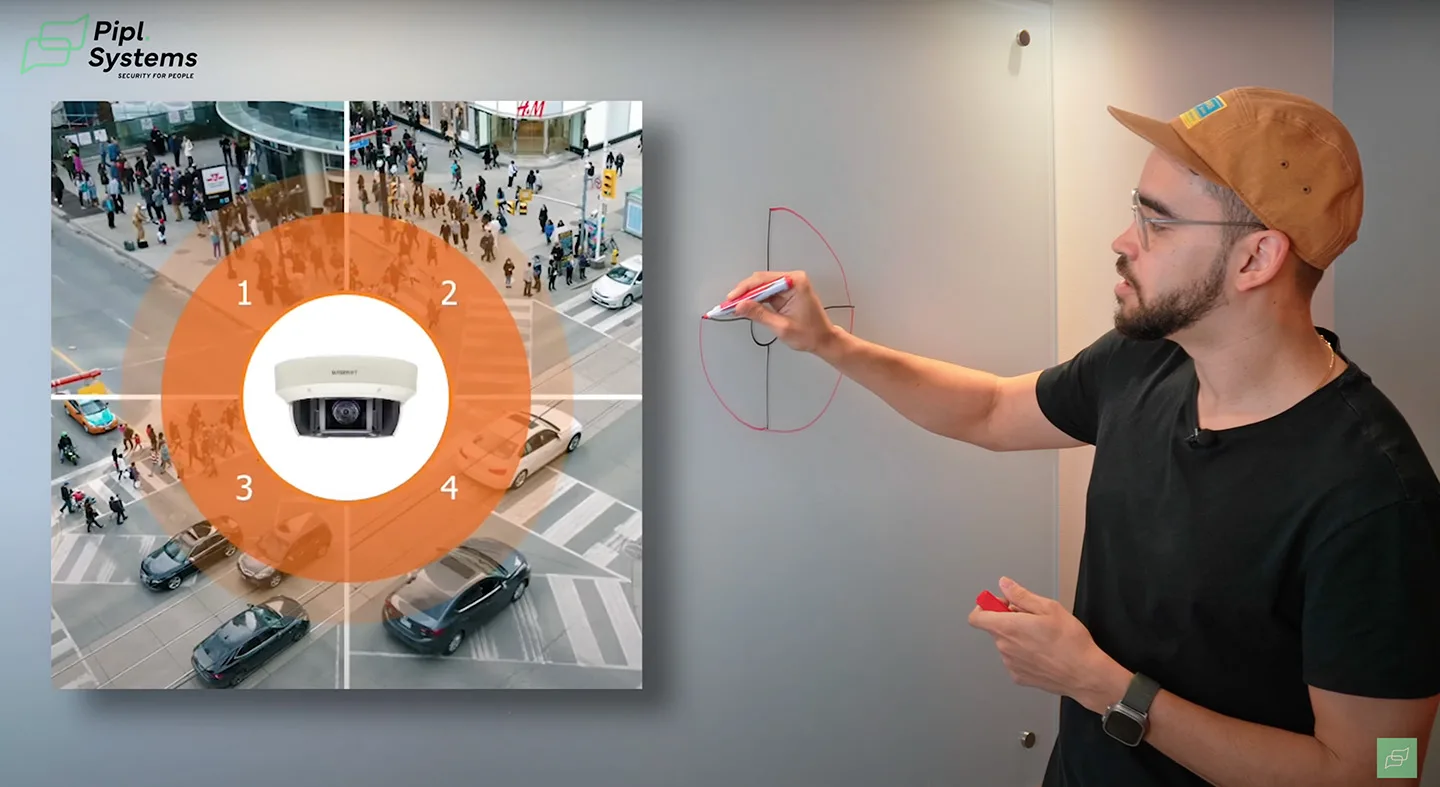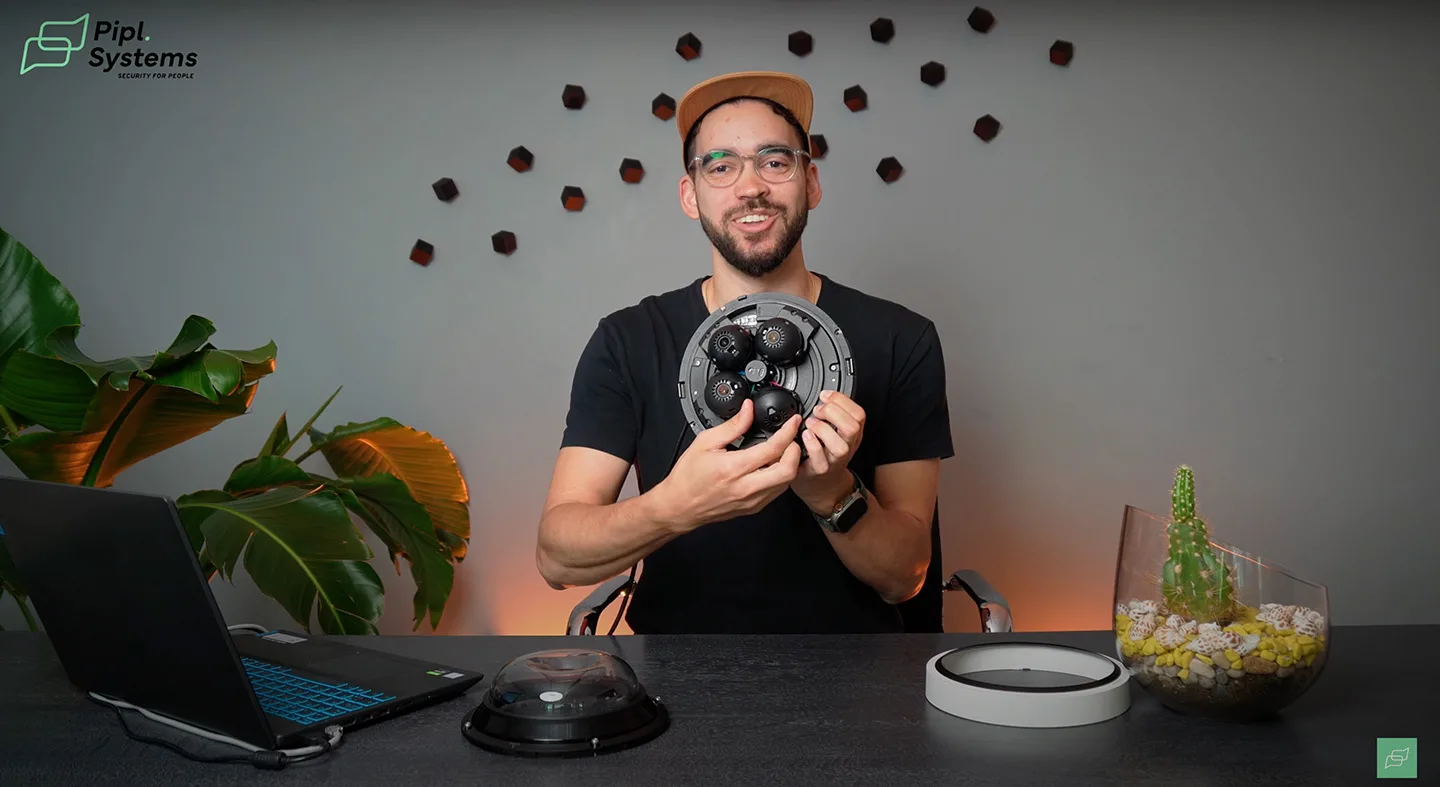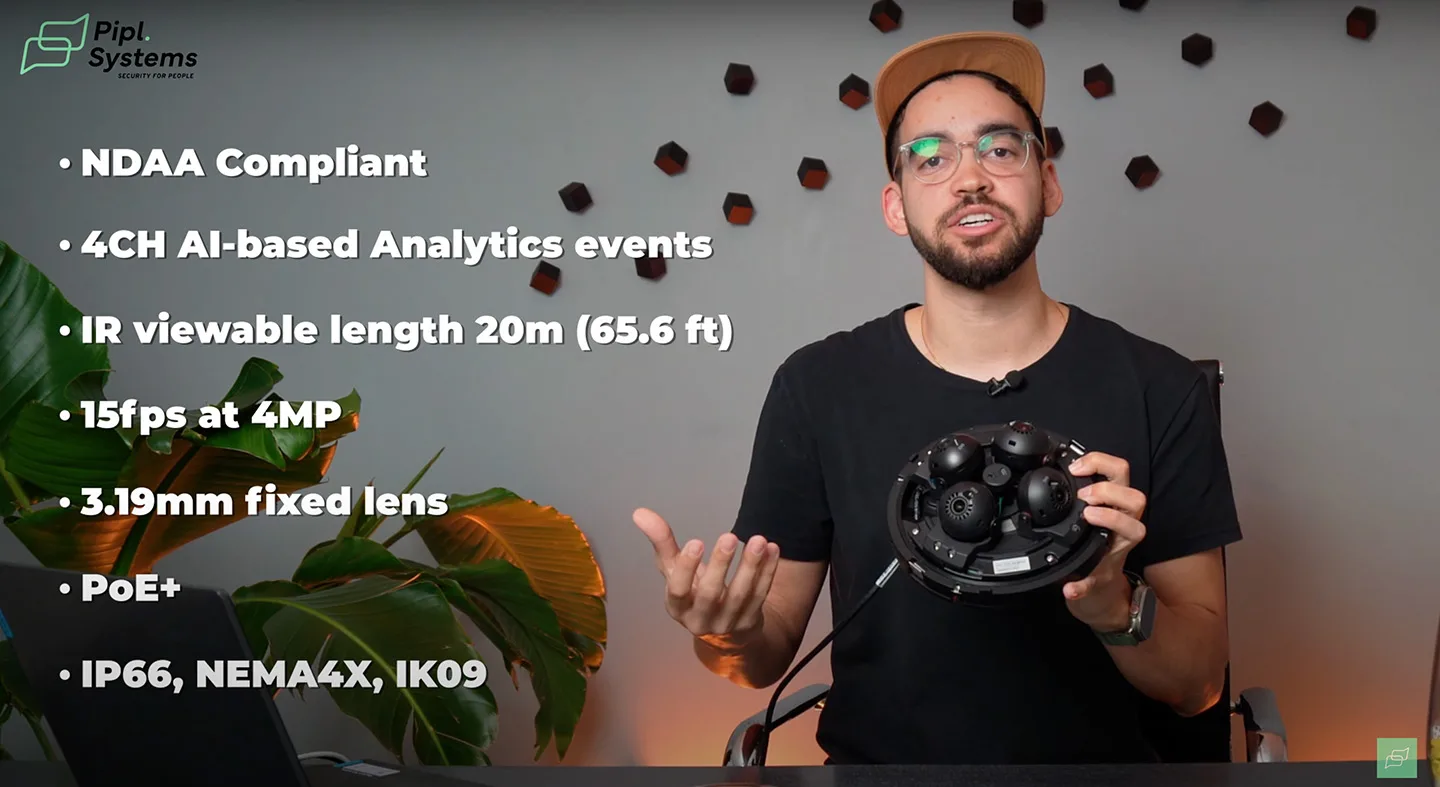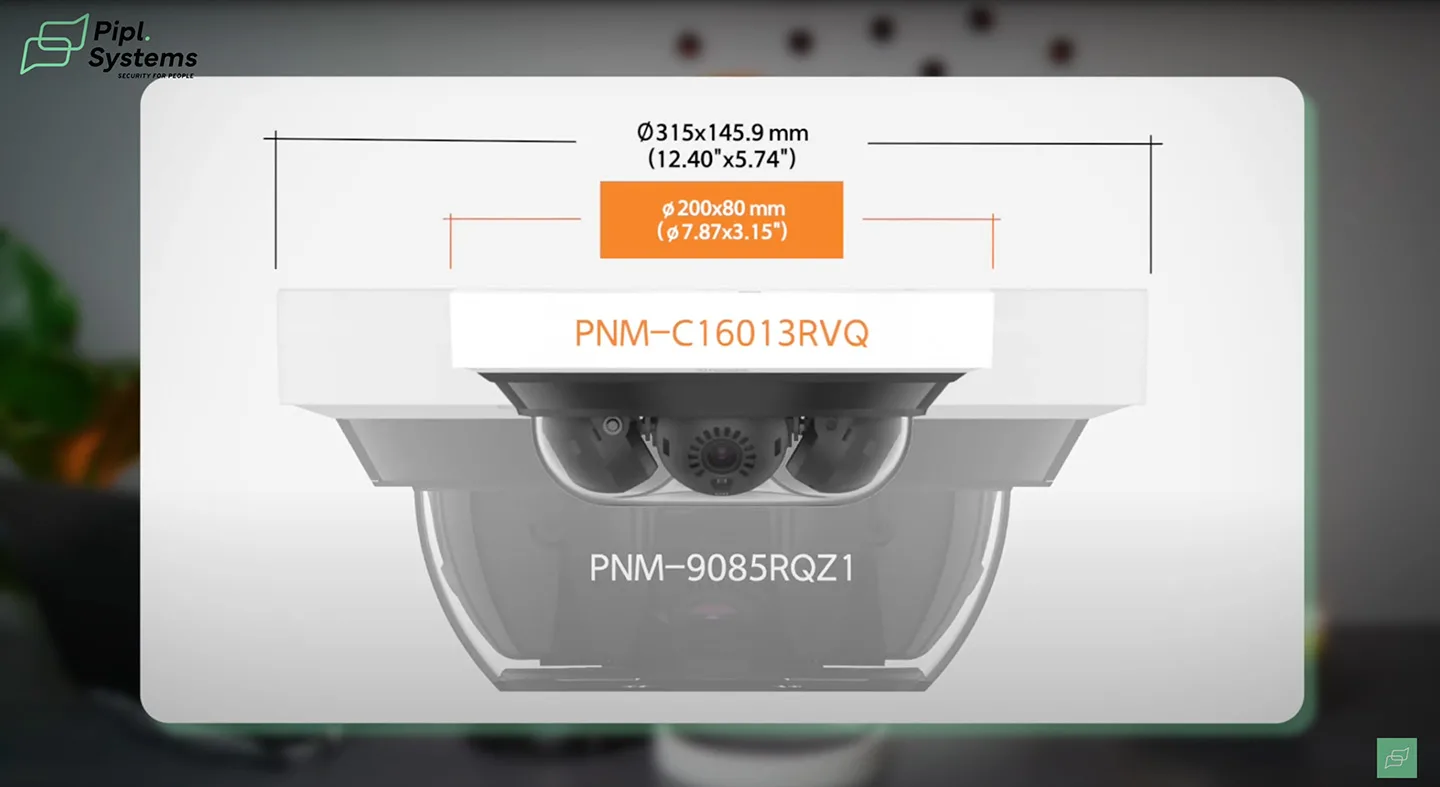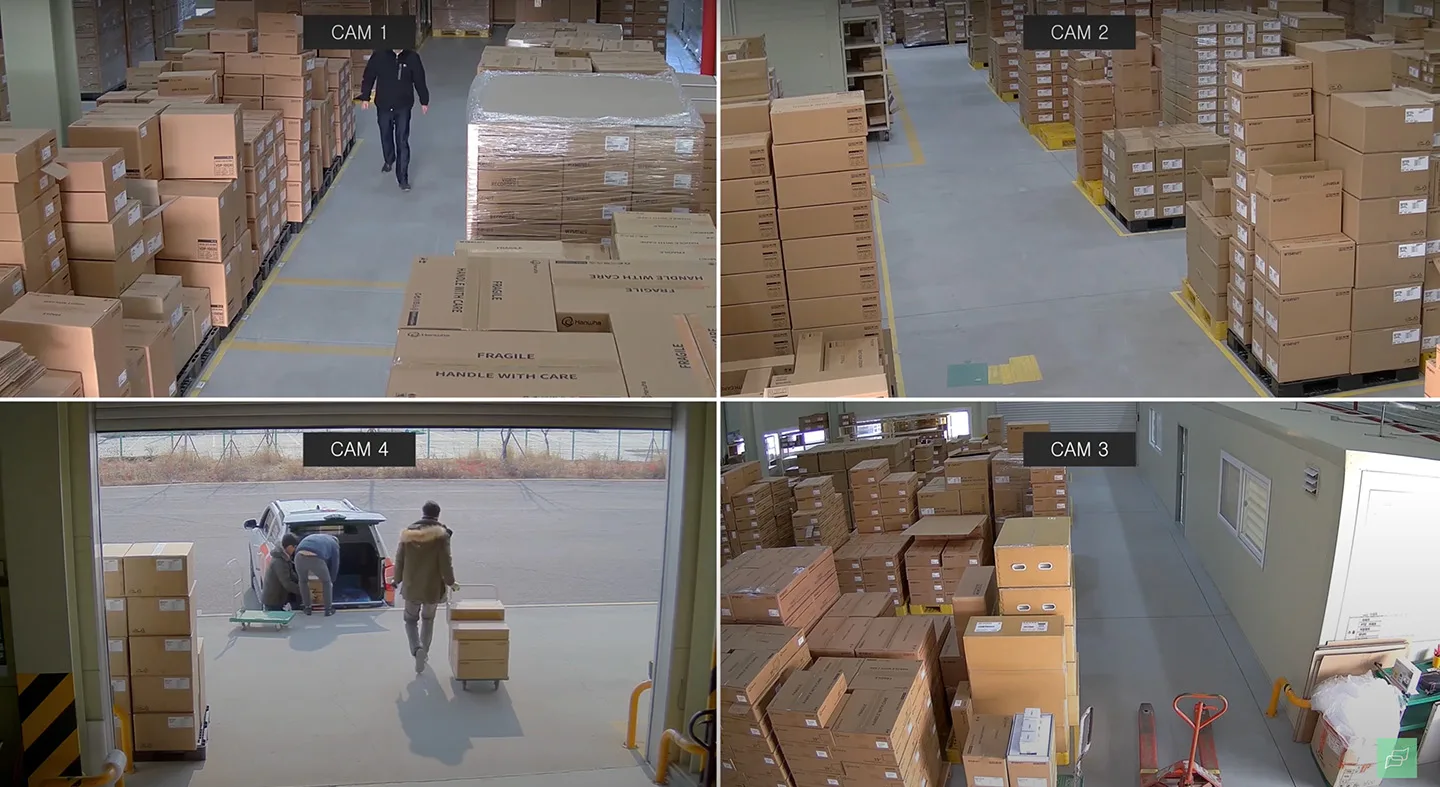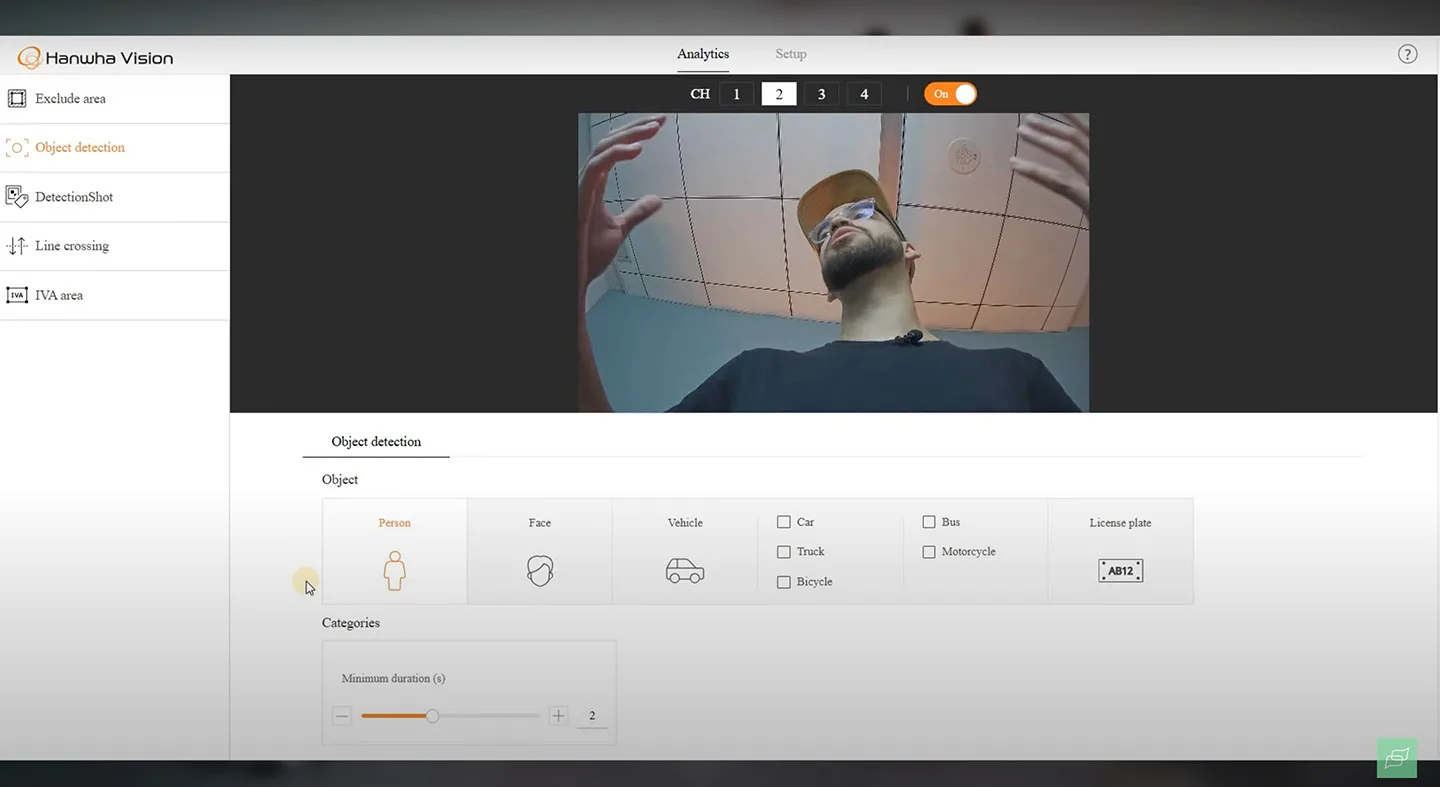Welcome to the Pipl Systems Media Portal! In today’s article, we’ll delve into the world of multisensor cameras, focusing on Hanwha’s latest innovation, the PNM-C16013RVQ. This powerful tool is revolutionizing the way professional installers and integrators approach security camera installations.
Do you need to install multiple cameras in one place to cover various angles? Then don’t miss this article! Our expert, Jeremie Lusignan, explores the benefits of multi-directional cameras, focusing on the Hanwha PNM-C16013RVQ. He explains the ease of installation, time and cost savings, and the powerful customizability of this new multisensor camera. Learn about its technical features, AI capabilities, and how to set it up for optimal performance.
Features and Benefits of a Multisensor Camera
Multisensor cameras, also known as multidirectional cameras, house multiple camera sensors within a single housing unit. This design offers several advantages:
- Cost-Effective Installation: With multisensor cameras, you only need one cable and one IP address, significantly reducing installation time and cost. For instance, the Hanwha PNM-C16013RVQ combines four cameras into one unit, simplifying both the setup and the maintenance process.
- Comprehensive Coverage: These cameras can cover a 360-degree field of view, eliminating blind spots and providing comprehensive surveillance in areas where multiple cameras would otherwise be necessary.
- Reduced Licensing Fees: When integrating into video management systems (VMS) like Hanwha’s Wave, a single license can cover the entire multisensor camera, as opposed to requiring separate licenses for each individual camera.
Illustration of the Capabilities of Different Multisensor Cameras
Two-Channel Multisensor Cameras
Best Use Case: L-Shaped Corridors
A two-channel multisensor camera is ideal for monitoring L-shaped corridors. Installed at the corner, it can cover both sides of the corridor, minimizing blind spots and maximizing coverage with a single device.
Three-Channel Multisensor Cameras
Best Use Case: Reception Areas
Three-channel multisensor cameras excel in monitoring reception areas. With one lens covering the entrance and the other two monitoring the adjacent corridors, these cameras provide comprehensive surveillance of the entire area from a single vantage point.
Four-Channel Multisensor Cameras
Best Use Case: Warehouses and Large Open Spaces
The four-channel multisensor camera, such as the Hanwha PNM-C16013RVQ, is perfect for large, open spaces like warehouses. It provides 360-degree coverage, ensuring there are no blind spots. The ability to adjust each lens independently allows for tailored coverage, focusing on both close-up and distant areas.
Technical Features of Hanwha PNM-C16013RVQ
The Hanwha PNM-C16013RVQ is a standout model in the multisensor security camera system market, featuring:
- 4 x 4MP Sensors: Each sensor provides 4 megapixels of resolution, ensuring high-quality footage.
- AI Capabilities: Integrated AI technology enhances motion detection, object recognition, and analytics, making it a powerful tool for proactive security measures.
- IR Illumination: Equipped with infrared illumination, it ensures clear imaging even in low-light conditions.
- Customizable Lenses: Each lens can be independently adjusted to cover specific areas, offering unparalleled flexibility.
How to Set Up the Hanwha PNM-C16013RVQ for Optimal Performance
- Installation: Mount the camera in a central location to maximize coverage. Use a single cable for power and data transmission to simplify the setup.
- Configuration: Assign a single IP address to the camera and integrate it into your VMS, such as Hanwha’s Wave. Utilize the single license feature to save on costs.
- Lens Adjustment: Customize each lens’s field of view to cover specific areas of interest, ensuring comprehensive surveillance without overlapping blind spots.
- AI Features: Activate and configure the AI features to enhance detection and analytics, adjusting the settings to fit your specific security needs.
Multisensor cameras like the Hanwha PNM-C16013RVQ are transforming the security industry by providing comprehensive coverage, cost-effective installation, and advanced features in a single package. For professional installers and integrators, these cameras offer a powerful solution to complex surveillance challenges.
Subscribe to Pipl Systems email newsletter to stay informed about all the events in the security industry.
Location and Orientation of the Cameras Inside the Housing
The Hanwha PNM-C16013RVQ is designed with four lenses within a single housing, each of which can be independently oriented to cover different angles. Here’s a step-by-step look at how these lenses can be adjusted:
- Disassembly: To access and adjust the lenses, start by removing the cover. This involves twisting the cover to pop it off. The necessary tools for this process are provided in the camera’s packaging, including a small screwdriver for quickly removing screws.
- Lens Adjustment: Inside the housing, you will find four lenses, each labeled as Channel 1, Channel 2, Channel 3, and Channel 4. These lenses are mounted on a rail mechanism, allowing for smooth sliding and positioning. You can move each lens to the desired angle to cover specific areas effectively.
- Custom Orientation: For instance, you can point one lens towards a long corridor, another towards an entrance, and the remaining two to cover other critical points. This flexibility ensures that no area is left unmonitored.
Technical Features (Specification) of Hanwha PNM-C16013RVQ Camera
The Hanwha PNM-C16013RVQ stands out due to its advanced specifications and features:
- Resolution: Each of the four lenses provides 4 megapixels of resolution, delivering clear and detailed images.
- AI Capabilities: The camera is equipped with advanced AI functionalities, allowing for features such as person detection, vehicle detection, and license plate recognition. Each lens can be configured with different AI tasks, enhancing the camera’s versatility.
- Infrared (IR) Illumination: The camera includes IR LEDs, ensuring effective night-time surveillance by providing clear images in low-light conditions.
- Weather Resistance: The camera is built to withstand harsh environmental conditions, making it suitable for both indoor and outdoor installations.
- Single IP Address: Despite having four lenses, the camera operates with a single IP address, simplifying network setup and reducing licensing costs when integrated with VMS platforms like Hanwha’s Wave.
About the Camera’s Powerful Customizability
One of the standout features of the Hanwha PNM-C16013RVQ is its powerful customizability:
- Independent Lens Movement: Each lens can be adjusted independently to cover specific areas of interest. This flexibility allows for tailored surveillance setups that can be modified as needs change.
- AI Functionality on Each Channel: The AI capabilities of the camera are not restricted to a single task per camera. Instead, each lens can perform different AI-driven tasks. For example, Channel 1 could be set for person detection, Channel 2 for vehicle detection, Channel 3 for facial recognition, and Channel 4 for license plate recognition.
- Versatile Mounting Options: The camera can be mounted in various orientations and positions, ensuring optimal coverage for diverse environments such as schools, hospitals, and retirement homes.
The Importance of the Small Size of the Hanwha Multidirectional Camera
The compact size of the Hanwha PNM-C16013RVQ brings several important benefits:
- Ease of Installation: The smaller size makes the camera lighter and easier to install, especially in challenging locations. This is particularly beneficial for installers who need to work in tight spaces or on high ceilings.
- Aesthetics and Discreteness: In environments like hospitals, schools, and retirement homes, a large and obtrusive camera can be intimidating. The compact design of the PNM-C16013RVQ allows it to blend seamlessly with the surroundings, maintaining the security and safety of the area without being a deterrent or causing discomfort.
- Enhanced Flexibility: The small size does not compromise the functionality of the camera. It still offers robust features and powerful customizability, making it a versatile choice for various surveillance needs.
The Hanwha PNM-C16013RVQ multisensor camera exemplifies the advancements in security technology, offering unparalleled flexibility, comprehensive coverage, and advanced AI capabilities in a compact form factor. For professional installers and integrators, it presents an ideal solution for a wide range of surveillance scenarios.
Subscribe to Pipl Systems email newsletter to stay informed about all the events in the security industry.
Only Practical Functions, No Unnecessary Equipment
The Hanwha PNM-C16013RVQ is engineered to offer the essential features without the unnecessary frills. Here’s a breakdown of its practical functionalities:
- Fixed Lenses: Unlike more expensive motorized lenses, the fixed lenses on the PNM-C16013RVQ are more cost-effective while still providing high-quality surveillance.
- 4MP Resolution: Each of the four lenses offers 4 megapixels, which is sufficient for most surveillance needs without overburdening the storage and network infrastructure.
- Night Vision: Equipped with IR LEDs, this camera ensures clear images even in low-light conditions, making it reliable around the clock.
- Local Storage: The inclusion of slots for two micro SD cards allows for local storage, providing a backup option and increasing the camera’s versatility.
By focusing on these practical aspects, Hanwha ensures that the PNM-C16013RVQ remains accessible to a wider range of projects, making advanced multi-directional technology available to more users.
How the AI Works and How to Set It Up Inside the Different Channels
The AI capabilities of the Hanwha PNM-C16013RVQ significantly enhance its functionality. Here’s how it works and how you can set it up:
- Independent AI Functions for Each Channel: Each lens can be programmed with different AI tasks. For example, Channel 1 can be set for person detection, Channel 2 for vehicle detection, Channel 3 for face recognition, and Channel 4 for license plate recognition.
- Accessing the AI Setup:
- Web Interface: Access the camera’s web interface to configure the AI settings. Each channel is listed separately, allowing you to customize the AI functionalities independently.
- Wise AI Analytics: Navigate to the Wise AI section within the web interface. Here, you can select the desired analytics for each channel. For instance, set up person detection on Channel 1 by selecting the appropriate option and defining the detection zones.
- Configuring Detection Zones: Within each channel, you can define specific zones for various types of detection (e.g., line crossing, object appearance/disappearance). This customization ensures that the camera’s AI focuses on the most critical areas.
- Customizable Alerts: Set up alerts for each AI function to receive notifications based on specific triggers. This helps in real-time monitoring and quick response to incidents.
You may also be interested in previous articles about solutions from Hanwha Vision:
How to Connect a Hanwha Security Camera System to Your Phone Using the Wisenet Wave App
NVR Inside of a Surveillance Camera: Revolution or Bust? | Hanwha SolidEDGE
Leave a Comment to Create a Video About the AI Functionality of Hanwha Cameras
To provide even more value, we’re offering an interactive opportunity for our audience. If you want a detailed video tutorial on setting up AI functionality in Hanwha cameras, please leave a comment below. We will create comprehensive video guides tailored to your needs, ensuring you get the most out of your Hanwha surveillance system.
Conclusion
Throughout this series, we’ve delved into the advantages and features of multisensor cameras, particularly focusing on the Hanwha PNM-C16013RVQ. Here’s a quick recap of the key points:
- Introduction: Multisensor cameras like the Hanwha PNM-C16013RVQ offer comprehensive surveillance coverage with fewer devices, reducing installation complexity and costs.
- Features and Benefits: The PNM-C16013RVQ provides high-resolution imaging, AI capabilities, and practical functionalities such as fixed lenses and night vision.
- Technical Specifications: This camera boasts 4MP resolution for each lens, advanced AI for individual channels, and local storage options.
- Customizability: The ability to independently adjust each lens and customize AI settings for each channel makes this camera highly versatile and adaptable to various surveillance needs.
- Practical Design: The compact size and practical features ensure that the PNM-C16013RVQ is suitable for diverse environments, from schools to hospitals to industrial settings.
Subscribe to Pipl Systems email newsletter to stay informed about all the events in the security industry.

To access a special offer on Hanwha Vision products, simply visit the Hanwha Vision page on the Pipl Systems website and make a request. Our team will connect you with a Hanwha Vision representative in your region, who will assist you in obtaining an offer on favorable conditions tailored to your requirements. Take advantage of this opportunity to enhance your security systems with cutting-edge Hanwha Vision products. Visit our website and submit your request today to unlock exclusive benefits and secure your organization’s assets.

